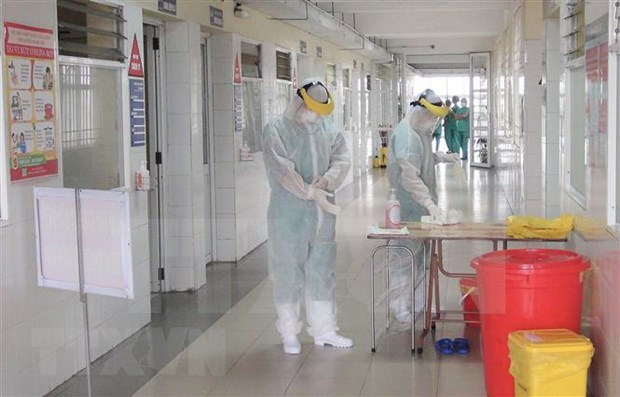 |
|
Medical workers at the acute respiratory hospital No2 in Quang Ninh in protective gear |
Among the new cases, three (No 164, 165 and 166) were found among those who returned abroad and have been under quarantine immediately after their entry.
Patient 167 is a Danish tourist, who arrived in Hanoi on March 7. She has travelled to Ha Giang, Hue, Hoi An and stayed at various hotels. Under the requirement for passengers to have a COVID19-free certification, she took the test in Hanoi on March 24 and was positive for SARS-CoV-2.
Patients 168 and 169 are staff members supplying hot water at Bach Mai hospital. Those two cases were found positive after tests were conducted on nearly 5,000 staff members, patients and patients’ carers at the hospital following the discovery of several COVID-19 cases among medical workers and patients there.
After investigation, the Health Ministry said there is a possibility that there is a source of infection among patients’ caretakers who brought the virus from outside.
The hospital has temporary closed down for quarantine.
Earlier, on March 27 evening Vietnam announced 10 more cases of COVID-19.
Four among the new 10 patients returned from abroad and entered Vietnam on March 22. Three of them, numbered from 154 to 156, were students returning from the UK, all on flight VN0050 from London to Can Tho on March 22, the same flight with patient 145.
Meanwhile, patient 160 returned from Madrid via Moscow to Ho Chi Minh City. She had contact with her SARS-VoV-2-positive sister in Spain one month ago, and showed symptoms of cough and sore throat from March 20.
All those four people had been quarantined upon arrival.
Patients numbered from 157 to 159 were foreigners who had close contact with COVID-19 patients at Buddha Bar in Ho Chi Minh City.
The remaining three patients numbered 161, 162 and 163 are all related to patient 133 at Hanoi’s Bach Mai hospital.
Patient 161 is 88 years old, and was in the same hospital room with patient 133 from March 17 to 22. Patients 162 and 163 are her family members.
According to the health ministry’s medical examination and treatment management department, COVID-19 patients are being treated at 20 medical facilities nationwide.
On March 27, three patients, two British citizens (patients 22 and 23) and a Vietnamese woman (patient 35), were discharged from hospital. They will undergo further quarantine for the next 14 days.
Three patients discharged from in Da Nang hospital
Two of them are British tourists who flew from Hanoi to Da Nang on March 2 and tested positive for SARS-CoV-2 that causes the COVID-19 pandemic on March 8.
The other is a 29-year-old saleswoman of the Dien May Xanh electronics supermarket in Hai Chau district, Da Nang city, who had come into direct contact with the British nationals before being confirmed positive for the virus on March 9.
The three are now in stable health with no symptoms like fever, cough and breathing difficulties, after testing negative for the coronavirus at least three times in a row.
However, they will still be put in quarantine at accommodation establishments and home for 14 days.
Hanoi cuts 80 percent of bus trips over COVID-19 fears
The Hanoi Transport Service Corporation (Transerco) has cut more than 7,500 bus trips per day, equivalent to nearly 80 percent of the total trips.
The adjustment will last from March 26 until April 5, amid the peak of COVID-19 in the capital city.
Buses will operate every 45 to 60 minutes per trip instead of five to 20 minutes.
Buses will start later and finish earlier than before, from 6am to 8pm every day instead of 5am to 10pm.
Transerco will report to local authorities on the move and propose further adjustments if necessary.
Since March 22, the company cut 900 bus trips per day on 28 routes.
The move follows Prime Minister Nguyen Xuan Phuc’s order to suspend bus operations or cut down on bus trips.
Chairman of the Hanoi People’s Committee Nguyen Duc Chung also recommended people to refrain from using public transport to prevent SARS-CoV-2 transmission.
HCM City approves 2.75 trillion VND package for COVID-19 fight
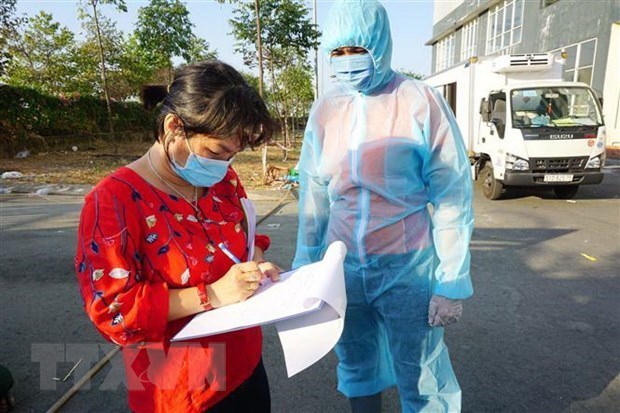 |
|
|
The People’s Council of Ho Chi Minh City has approved a financial package worth 2.75 trillion VND (120 million USD) for the prevention and control of the COVID-19 epidemic and support labourers affected by the epidemic.
The 19th-tenure council’s extraordinary session agreed that the money will be sourced from the city’s budget reserve.
With the package, the city will pay meal subsidiary to quarantined people, COVID-19 patients, and daily allowance to medical workers, military staff and other forces engaged in epidemic control work.
An amount worth 323 billion VND will be reserved for the case 10,000 people are quarantined and 100 people need treatment for SARS-CoV-2 infection.
The city plans to spend 112 billion VND to ensure three-month supply of face masks for students and environmental sanitary workers.
Teachers and staff members of private pre-school establishments who lose jobs due to COVID-19 but are not entitled to unemployment benefits will receive 1 million VND in support each month, with the total amount estimated at 1.8 trillion VND.
The package will also pay for the purchase of 10 specialised vehicles for transporting COVID-19 patients, as well as training and communication activities serving the fight against the epidemic./.
Vietnam Embassy in US supports citizens
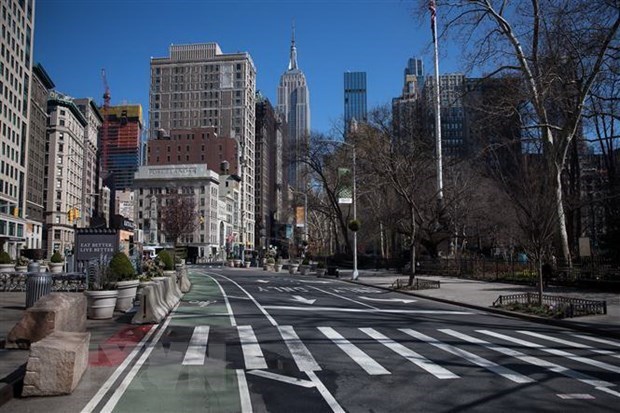 |
|
A deserted street in New York during COVID-19 pandemic
|
The Vietnamese Embassy in the US is taking measures to support Vietnamese citizens amid concern about complicated developments of the COVID-19 epidemic in the US and new regulations of many countries, including Vietnam, regarding entry-exit and aviation transport.
The embassy has worked with Vietnam’s general consulates in Houston and San Francisco and the Vietnamese mission in New York to raise awareness among students about the need to avoid travelling back to Vietnam at this moment so as to reduce the risk of contracting disease and overloading of medical service in the home country.
The embassy set up three hotlines and four email addresses, which operate around the clock seven days a week to provide information and help regarding documents and procedures for Vietnamese citizens.
The embassy has coordinated with the general consulates in Houston and San Francisco to help nearly 40 students who were stuck at Dallas airport (Texas) after their flights were cancelled.
The embassy has posted on its website guidance on COVID-19 with regularly updated information on the disease and new pandemic-related policies and rules of Vietnam and the host country, along with warning against possible risks.
The embassy has coordinated with associations of Vietnamese youth and students in the US to help Vietnamese students seek new accommodations when their schools close down, and raise support for the students.
At the same time, the embassy on March 25 published an electronic form for those who want to return to Vietnam to collect information on the need to report to the home country for consideration.
Regarding to reports that a number of crew members on the US’s aircraft carrier Theodore Roosevelt tested positive for SARS-CoV- 2 after the vessel visited Vietnam, Vietnamese Ambassador to the US Ha Kim Ngoc said when the carrier docked at Da Nang port and during the visit, both the Vietnamese and US sides had worked together to implement disease preventive measures. The visit was a success, contributing to deepening the Vietnam-US comprehensive partnership and maintaining peace, stability and stability in the region.
The ambassador made clear that during and after the Vietnam visit, the US carrier received many flights of US military, therefore the process of investigation is still underway with no conclusion yet on the cause and source of infection of the COVID-19 cases on the carrier.
Chief of Naval Operations Adm. Mike Gilday told the press that he thinks it would be difficult to tie down these active cases to the Da Nang port visit. “We’ve had aircraft flying to and from the ship, and so we just don’t want to say it was that particular port visit. We took great precautions when that crew came back from that shore period to do enhanced medical screening of the crew,” Gilday told reporters last week./.
COVID-19: Hai Phong sprays disinfectant over entire city
The northern port city of Hai Phong will spray disinfectant over entire city two to three times a week during a period of 15 days, starting March 27, in an effort to cope with new developments in the COVID-19 epidemic in the country.
Chairman of the municipal People’s Committee Nguyen Van Tung has ordered an immediate halt of meetings, festivals, religious rituals and other public activities.
Only establishments supplying essential goods and services such as food and foodstuff, pharmaceuticals, petrol, daily-use goods and medical care are allowed to open while those involved in non-essential business activities and services must close throughout April 15l
The city’s leader also assigned the heads of local agencies, administrations and businesses to encourage online working and minimize sending staff members on working trips to other localities.
He requested that foreign experts, technicians and workers who work in Hai Phong-based companies but live in other localities must stay in Hai Phong throughout April 15 to curb the spread of COVID-19 from other localities to the city.
Transport businesses are required to cut flights, trains and buses from localities with COVID-19 outbreaks to Hai Phong.
The city’s administration is looking for local residents who attended a Muslim gathering in Kuala Lumpur, Malaysia, from February 28 to March 1, to check whether they are infected with the coronavirus.
Hai Phong has yet to record any COVID-19 case so far.
As of March 27 morning, Vietnam recorded 153 cases positive for SARS-CoV-2 that causes COVID-19, 17 of whom had fully recovered. Later the same day, three more cases in Da Nang city were also discharged from hospital.
The national steering committee for the pandemic prevention and control reported at its meeting on March 27 that 37 COVID-19 patients have tested negative once while eight other tested negative twice and five negative thrice. Three patients are in serious conditions and currently under intensive care at the Hanoi-based National Hospital for Tropical Diseases./.
German, Russian media hail Vietnam’s fight against COVID-19
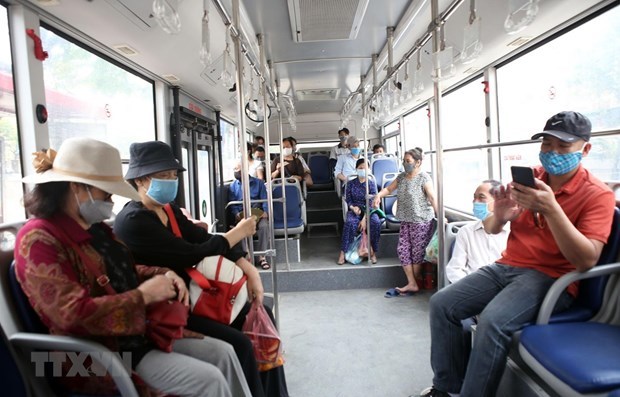 |
|
On a bus in Hanoi
|
German newswire Deutsche Welle on March 26 ran an article hailing Vietnam’s effective and timely measures in the fight against COVID-19 pandemic.
The article said though Vietnam shares a 1,100km -long border with China, and has a weak health care system and a low budget for combating the epidemic, it has only reported about 150 infections and no fatalities since the outbreak began in January.
Vietnam has a done a good job thus far in fighting the epidemic which is raging in many countries worldwide, it said, quoting a report by the World Health Organisation as saying that in Germany alone, over 47,000 people have been infected with SARS-CoV-2, resulting in more than 220 fatalities.
According to the article, the Vietnamese government had "declared war" on COVID-19 as early as when the outbreak was still confined to China.
During a meeting, Prime Minister Nguyen Xuan Phuc said it would not be long before the virus reached the country. "Fighting this epidemic, means fighting the enemy," he said.
To take the fight, Vietnam mobilised all resources, instituted rigorous quarantine policies, and carried out complete tracing of all people who came in contact with the infected. These measures were taken much earlier in the course of the epidemic than in China, where lockdowns of entire cities were used as the last resort to keep the virus from spreading further.
For example, on February 12, Vietnam put an entire commune of 10,000 people near Hanoi under quarantine for three weeks. At this time, there were only 10 confirmed COVID-19 cases in the entire country.
While Western countries like Germany only documented those infected and their direct contacts, Vietnam kept track of second, third and fourth levels of contact to infected persons. All of these people were then placed under successively stringent levels of movement and contact restrictions.
And from very early on, anyone arriving in Vietnam from a high-risk area would be quarantined for 14 days. All schools and universities have also been closed since the beginning of February.
The author wrote that a majority of Vietnamese people agreed with and believed in the government during the fight.
Meanwhile, the Sputnik radio of Russia on March 26 also lauded Vietnam’s experience in fighting COVID-19, saying that Vietnam has set an example in the effort.
Vietnam had responded quickly when the disease was reported in China by strictly controlling the border with China and quarantining people coming from China and other disease-hit countries.
The radio underlined that the Vietnamese Government has timely informed the people of preventive measures, and Vietnamese experts successfully developed SARS-CoV-2 test kits, which are not only being used in Vietnam but also exported to other countries.
It added that the Vietnamese people have the tradition of staying united to strive overcoming difficulties, which helped the country effectively constrain the epidemic./.
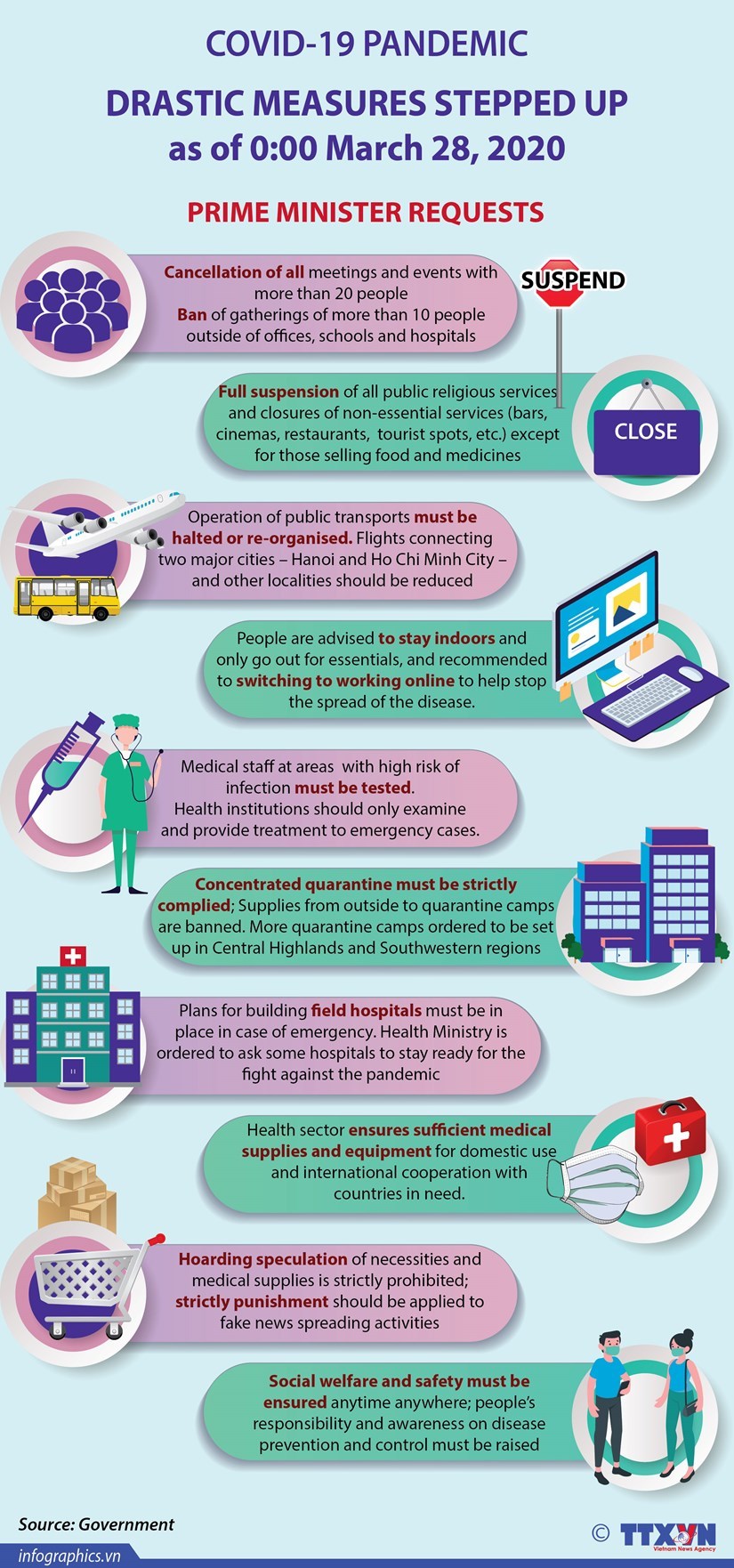 |
VNA/VNN
 Six new COVID-19 patients were detected after the last announcement this morning, raising the total number of cases in Vietnam to 169 as of 06:30 on March 28.
Six new COVID-19 patients were detected after the last announcement this morning, raising the total number of cases in Vietnam to 169 as of 06:30 on March 28.